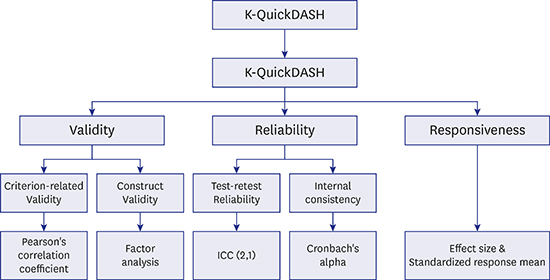1. Döring AC, Nota SP, Hageman MG, Ring DC. Measurement of upper extremity disability using the Patient-Reported Outcomes Measurement Information System. J Hand Surg Am. 2014; 39(6):1160–1165.
2. Tongprasert S, Rapipong J, Buntragulpoontawee M. The cross-cultural adaptation of the DASH questionnaire in Thai (DASH-TH). J Hand Ther. 2014; 27(1):49–54.

3. Covinsky KE, Lindquist K, Dunlop DD, Yelin E. Pain, functional limitations, and aging. J Am Geriatr Soc. 2009; 57(9):1556–1561.

4. Lee JY, Lim JY, Oh JH, Ko YM. Cross-cultural adaptation and clinical evaluation of a Korean version of the Disabilities of Arm, Shoulder, and Hand outcome questionnaire (K-DASH). J Shoulder Elbow Surg. 2008; 17(4):570–574.

5. Beaton DE, Wright JG, Katz JN. Upper Extremity Collaborative Group. Development of the QuickDASH: comparison of three item-reduction approaches. J Bone Joint Surg Am. 2005; 87(5):1038–1046.
6. Kennedy CA, Beaton DE, Smith P, Van Eerd D, Tang K, Inrig T, et al. Measurement properties of the QuickDASH (Disabilities of the Arm, Shoulder and Hand) outcome measure and cross-cultural adaptations of the QuickDASH: a systematic review. Qual Life Res. 2013; 22(9):2509–2547.

7. Jeon SH, Lee JH, Chung MS, Baek GH, Oh JH, Lee YH, et al. Responsiveness of the Korean version of the Disabilities of the Arm, Shoulder and Hand questionnaire (K-DASH) after carpal tunnel release. Clin Orthop Surg. 2011; 3(2):147–151.

8. Fayad F, Lefevre-Colau MM, Gautheron V, Macé Y, Fermanian J, Mayoux-Benhamou A, et al. Reliability, validity and responsiveness of the French version of the questionnaire Quick Disability of the Arm, Shoulder and Hand in shoulder disorders. Man Ther. 2009; 14(2):206–212.

9. Resnik L, Borgia M. Reliability, validity, and responsiveness of the QuickDASH in patients with upper limb amputation. Arch Phys Med Rehabil. 2015; 96(9):1676–1683.

10. Padua L, Coraci D, Erra C, Pazzaglia C, Paolasso I, Loreti C, et al. Carpal tunnel syndrome: clinical features, diagnosis, and management. Lancet Neurol. 2016; 15(12):1273–1284.

11. Gong HS, Baek GH, Oh JH, Lee YH, Jeon SH, Chung MS. Factors affecting willingness to undergo carpal tunnel release. J Bone Joint Surg Am. 2009; 91(9):2130–2136.

12. Unglaub F, Wolf E, Goldbach C, Hahn P, Kroeber MW. Subjective and functional outcome after revision surgery in carpal tunnel syndrome. Arch Orthop Trauma Surg. 2008; 128(9):931–936.

13. Appleby MA, Neville-Smith M, Parrott MW. Functional outcomes post carpal tunnel release: a modified replication of a previous study. J Hand Ther. 2009; 22(3):240–249.

14. Gummesson C, Ward MM, Atroshi I. The shortened Disabilities of the Arm, Shoulder and Hand questionnaire (QuickDASH): validity and reliability based on responses within the full-length DASH. BMC Musculoskelet Disord. 2006; 7(1):44.

15. Niekel MC, Lindenhovius AL, Watson JB, Vranceanu AM, Ring D. Correlation of DASH and QuickDASH with measures of psychological distress. J Hand Surg Am. 2009; 34(8):1499–1505.

16. Park DJ, Kang JH, Lee JW, Lee KE, Wen L, Kim TJ, et al. Cross-cultural adaptation of the Korean version of the Boston carpal tunnel questionnaire: its clinical evaluation in patients with carpal tunnel syndrome following local corticosteroid injection. J Korean Med Sci. 2013; 28(7):1095–1099.

17. Hazra A, Gogtay N. Biostatistics series module 6: correlation and linear regression. Indian J Dermatol. 2016; 61(6):593–601.

18. Reio TG Jr, Shuck B. Exploratory factor analysis. Adv Dev Hum Resour. 2015; 17(1):12–25.

19. Bland JM, Altman DG. Cronbach's alpha. BMJ. 1997; 314(7080):572.
20. Koo TK, Li MY. A guideline of selecting and reporting intraclass correlation coefficients for reliability research. J Chiropr Med. 2016; 15(2):155–163.

21. Wi SM, Gong HS, Bae KJ, Roh YH, Lee YH, Baek GH. Responsiveness of the Korean version of the Michigan Hand Outcomes Questionnaire after carpal tunnel release. Clin Orthop Surg. 2014; 6(2):203–207.

22. Angst F, Schwyzer HK, Aeschlimann A, Simmen BR, Goldhahn J. Measures of adult shoulder function: Disabilities of the Arm, Shoulder, and Hand Questionnaire (DASH) and its short version (QuickDASH), Shoulder Pain and Disability Index (SPADI), American Shoulder and Elbow Surgeons (ASES) Society standardized shoulder assessment form, Constant (Murley) Score (CS), Simple Shoulder Test (SST), Oxford Shoulder Score (OSS), Shoulder Disability Questionnaire (SDQ), and Western Ontario Shoulder Instability Index (WOSI). Arthritis Care Res (Hoboken). 2011; 63:Suppl 11. S174–S188.
23. Angst F, Goldhahn J, Drerup S, Flury M, Schwyzer HK, Simmen BR. How sharp is the short QuickDASH? A refined content and validity analysis of the short form of the disabilities of the shoulder, arm and hand questionnaire in the strata of symptoms and function and specific joint conditions. Qual Life Res. 2009; 18(8):1043–1051.

24. Su Y. QuickDASH. J Physiother. 2014; 60(3):167.

25. Souza AC, Alexandre NMC, Guirardello EB. Psychometric properties in instruments evaluation of reliability and validity. Epidemiol Serv Saude. 2017; 26(3):649–659.
26. Parmelee PA, Tighe CA, Dautovich ND. Sleep disturbance in osteoarthritis: linkages with pain, disability, and depressive symptoms. Arthritis Care Res (Hoboken). 2015; 67(3):358–365.

27. Nicassio PM, Ormseth SR, Kay M, Custodio M, Irwin MR, Olmstead R, et al. The contribution of pain and depression to self-reported sleep disturbance in patients with rheumatoid arthritis. Pain. 2012; 153(1):107–112.

28. Itsubo T, Uchiyama S, Momose T, Yasutomi T, Imaeda T, Kato H. Electrophysiological responsiveness and quality of life (QuickDASH, CTSI) evaluation of surgically treated carpal tunnel syndrome. J Orthop Sci. 2009; 14(1):17–23.

29. Budd HR, Larson D, Chojnowski A, Shepstone L. The QuickDASH score: a patient-reported outcome measure for Dupuytren's surgery. J Hand Ther. 2011; 24(1):15–21.

30. Fisher DE, Ward MM, Hoffman HJ, Li CM, Cotch MF. Impact of sensory impairments on functional disability in adults with arthritis. Am J Prev Med. 2016; 50(4):454–462.











 PDF
PDF Citation
Citation Print
Print




 XML Download
XML Download